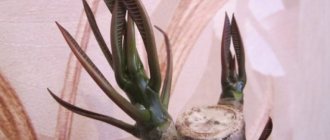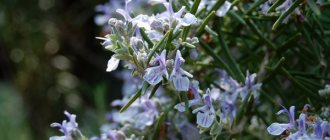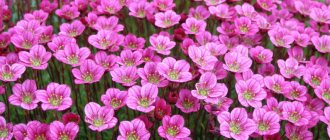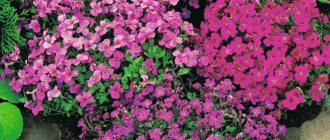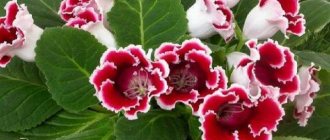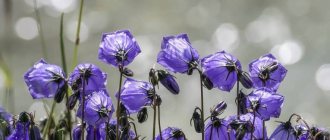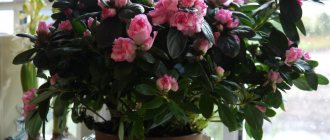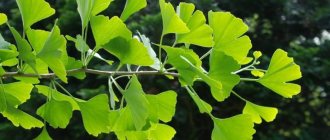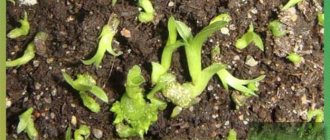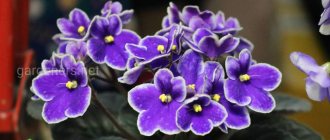OgorodGuruCom
Tips and tricks for gardeners
Popular
List of potato varieties that the Colorado potato beetle does not eat
Home › Vegetables › How to grow ornamental peppers from seeds at home
Decorative peppers are especially popular among amateur gardeners. It is not difficult to grow, so it can be kept indoors. Many varieties of the plant are edible and are used as a seasoning.
Characteristics of decorative pepper
Pepper has appeared in indoor floriculture quite recently; breeders have specially created varieties for home cultivation. The plant belongs to the Solanaceae family; Asia and America are considered to be its homeland.
The decorative perennial does not grow more than 40 cm, but even on such a miniature bush peppers are formed. The lifespan of the plant is about five years, and all this time it can actively bear fruit.
The shape and color of the fruits are varied. Flowering begins in May, and vegetables ripen in October.
Distinctive features
A heat-loving perennial plant from the Solanaceae family bears fruit in an artificial environment for 4-5 years, but indoor peppers can be grown as annuals. It is impossible to give a general description of the culture due to the wide variety of species, but there are features characteristic of most of them.
Varieties of decorative peppers
In fact, there is a wide variety of pepper flower varieties. Here are the most popular plants for indoor growing:
- The black pearl is distinguished by its attractive appearance. The variety is often used for decorative purposes, and is also used for making spices, sauces and seasonings.
- Ogonek stands out from the rest due to its large fruits, which can reach 40 grams. This variety is considered universal; it can be grown both in pots at home and in garden beds.
- Salute is the simplest and most unpretentious shrub crop to grow. The fruits have a fiery taste reminiscent of chili.
- Drakosha pepper looks very beautiful on the windowsill. The lush bush literally attracts attention to itself. The fruits are moderately spicy and are used in cooking and for garnishing preserves.
Regardless of whether the pepper flower is bitter or sweet, it needs care. It is especially important to provide the plant with conditions when growing indoors.
The Medusa pepper got its name because of its unusual appearance; the fruits actually resemble tentacles.
Popular varieties for indoor growing
Not all varieties of decorative peppers are suitable for home cultivation. The following representatives get along best in the apartment:
- Queen of Spades;
- Black Pearl;
- Poinsettia;
- Jamaica.
Note! When cultivating in an apartment, it is necessary to maintain a certain temperature regime in the room with flowers and monitor the humidity. Only in this case will the bushes bear fruit abundantly.
Edible ornamental peppers
Almost all varieties of indoor peppers can be eaten. However, most housewives do not use them for their intended purpose, as they do not want to spoil the visual appeal of the lush shrub.
Multi-colored decorative peppers
There are varieties that are especially attractive for indoor growing. They come in a variety of colors and look like a real rainbow:
- Jamaica;
- Queen of Spades;
- Baby.
The fruits stay on the bush for quite a long time. On average, they begin to fall off three months after full maturity.
The advantage of multi-colored peppers is their visual appeal, but colored fruits, as a rule, are inferior in taste to traditional varieties
Inedible decorative peppers
Decorative hot peppers can also be inedible; such varieties are usually grown for interior decoration. Their appearance is usually attractive, and the fruits themselves delight the eye with bright colors that stimulate the appetite.
In Russia you can meet only two representatives:
- The Clown variety is a small bush that grows no more than 35 cm. The vegetables themselves are elongated and red in color. The plant is not fussy; for regular fruiting it is enough to keep the pot in the sun, moisten the soil and spray it.
- Goldfinger is known for its long yellow peppers that point upward. This variety is classified as a miniature shrub crop; an adult plant barely reaches 25 cm.
Description and brief description
It is a mistake to think that decorative peppers appeared relatively recently. Trying to prolong the summer, our grandmothers grew it. At that time there were no seeds on the market, and for indoor pots they used either varieties intended for the garden, which sometimes sprouted, but were much smaller and more compact, or, if, of course, you were lucky, you managed to beg a few seeds from friends who had already successfully grown There are such indoor beauties all year round.
When the era of total shortage passed, and work on a personal plot ceased to be mandatory to provide the family with the necessary products, they began to look for other positive aspects in it. This is where breeders came to the rescue.
Today there are quite a few varieties of ornamental peppers. Some are quite successfully grown in garden beds and their owners do not even suspect that the “garden dweller” is notable for something other than its taste characteristics. Some were bred specifically for decoration, and consumption as food is considered secondary. Some are completely forbidden to eat, but there are also those that cost a lot of money and are found exclusively in botanical gardens or greenhouses of connoisseurs.
Reproduction methods
Multi-colored peppers reproduce in different ways. It is worth considering the most common options:
- Seeds are a common method of propagation. To do this, planting material is scattered over compost-humus soil. A small layer of soil is poured on top. The first shoots appear on the 15th day.
- By cuttings. To do this, in early spring, strong and healthy shoots are cut from the bush, then they are planted in separate flowerpots. But first, the tops must be pinched.
Growing from seeds is a more labor-intensive and time-consuming process. It's easier and faster to use cuttings.
Ornamental pepper seeds are similar to regular ones, but their size is much smaller
Necessary agrotechnical conditions
Caring for decorative peppers is practically no different from caring for flowers. They require the same conditions and activities.
Timing of seed sowing and pre-planting treatment, germination
Planting seed material in an apartment can be done at any convenient time. But it is best to plant ornamental peppers in February, and first, the seeds should be prepared and treated with growth stimulants.
It is also important to disinfect: to do this, they are placed for half an hour in a weak solution of potassium permanganate.
Important! To be sure that the seeds will sprout, you can germinate them in advance. To do this, the material is wrapped in a damp cloth and kept for a certain time.
Preparing containers and substrate, sowing seeds and germination conditions
Containers for the plant are selected according to the size of the root system. Replanting is carried out as they grow; young peppers need to change the pot twice a year. For older bushes once every 2-3 years.
The culture loves a loose substrate; it is better to take purchased soil intended for peppers. A drainage layer is poured onto the bottom of the flowerpot.
For seed material, it is better to purchase special peat cups. In this case, the risk of damage to the roots during transplantation is reduced. Sowing is carried out to a depth of 1 cm, after which the container is covered with film or glass and left in this state until germination.
Further care before transplantation
After planting the seed, there is no need to water the soil; it is quite enough to moisten the soil by spraying. If the soil was well fertilized for planting, then additional fertilizing is not required. Fertilizers are applied only when the seedlings stop growing. At this time, universal seedling complexes are added.
Pepper transplant
Hot ornamental peppers need to be replanted when more than five leaves form on the stem. To do this, you will need a new container with a volume of 1 liter. It is imperative to lay a drainage layer at the bottom of the flowerpot, this can be:
- coarse sand;
- pebbles;
- ceramic fragments.
The seedlings should be transported with a ball of earth so as not to damage the young and immature roots. Then add more soil and water it thoroughly. After transplanting, place it in a place where there is partial shade.
Small peppers need to be replanted at least twice a year, an adult plant once every 2-3 years
How to grow indoor peppers in a pot?
For cultivation, a sequence of rules is followed:
- Seeds are selected, they and containers for planting are disinfected.
- Buy soil or make it yourself.
- To obtain a good result, maintain temperature and humidity conditions.
Seed preparation
Seeds can be purchased at the store or collected independently from ripe peppers. Before sowing, seeds are calibrated :
- Dip into a solution of water and table salt, mix and leave for a while.
- Weak seeds will remain on the surface. They need to be removed.
- Large seeds are treated with potassium permanganate and then with microelements, dipping bags of seeds into the solution. Without washing, the seeds are dried.
Reference ! Wood ash is also used for nutrition; it contains about 30 different elements. Ash is added to the water and the seeds are kept in solution for 3 hours.
Priming
Pepper loves soil that is neutral in composition . The substrate can be purchased at the store or mixed at home. To prepare the soil you will need turf soil, leaf humus and sand in equal quantities.
The soil should be permeable to air and have a loose consistency. For nutritional value, add a little humus or sawdust.
Gardeners advise adding agroperlite or vermiculite, which prevent soil compaction and retain moisture.
Planting container
For primary sowing, choose containers of 200-300 ml. Soil that has not been developed by roots will quickly oxidize if planted immediately in a large pot. In addition, overgrown roots will lead to a reduction in flowering. There must be a hole at the bottom to collect excess water , and a tray is placed under the pot. The growing container should have a capacity of approximately 2-3 liters.
When and how to plant?
The time for sowing seeds depends on the variety:
- Spring ripening seeds begin to be planted in November and late December.
- Summer plants - from April to May.
- Those that ripen in the fall - from mid-summer to the end of August.
- Pots for sowing are prepared with a capacity of approximately 0.2 liters. Drainage is laid out at the bottom of the container - 2-3 cm of sand or expanded clay.
- The earth is falling asleep. It is better to purchase the substrate in a store, this will give you more confidence that it is not contaminated with anything.
- First, the seeds are soaked for several hours. To do this, use a solution of potassium humate.
- After soaking, the seeds are placed in the ground, sprinkled with soil and compacted.
- Containers or containers are covered with transparent film to create a greenhouse effect. The temperature must be maintained within 23-25oC.
- After 1-2 weeks, the first shoots form and the shelter is removed.
- The temperature must be lowered to 16-18°C after 5 days.
- Periodically moisten the soil with settled water.
- After the appearance of 5-6 strong leaves, the plant is transplanted into a separate container.
Mass planting for ornamental peppers is not used; each pepper must have a separate pot.
Caring for indoor peppers at home
Like any other crop, homemade peppers in a pot need care. Seedlings need to be monitored more carefully.
Conditions of detention
It is best to keep the pepper on an eastern or western windowsill. Plants that bear fruit all year round will need additional lighting in the winter.
Note ! It is quite simple to understand that peppers are deficient in light. The shoots begin to develop poorly and the inflorescences do not form.
It is also important to monitor humidity, ventilate the room daily, but in such a way that there are no drafts. The humidity in the room should be from 60 to 70%; if this is not possible, then place containers with liquid next to the plant.
Adult plant - care
At home, caring for peppers is similar to caring for indoor flowers, but taking into account the characteristics of the vegetable crop.
Choice of location, lighting, temperature
Peppers are natives of tropical regions where there is a lot of light and heat, so short daylight hours (less than 12 hours) negatively affect the development of the bush and fruits. There is not enough light in late autumn and winter, so it is necessary to compensate for its lack with artificial lighting. If possible, the plant can be placed on the western (eastern) windows; if the windows are southern, then provide shading or place the pot next to the window.
In a room where you can slightly lower the daytime temperature at night (23-25 °C), peppers actively grow and bear fruit, and they get sick less. This can be achieved by ventilation, but without drafts. The required humidity level is 60-70%. If the air is dry, then spray and place containers of water nearby.
Watering, fertilizing
The watering regime depends on weather conditions - in hot weather, water more often and in large volumes, on cold and cloudy days - less frequently. Use only settled water at room temperature. The soil in the container should be moist, but not wet. It is recommended to fertilize once every two weeks, alternating organic matter and mineral complexes.
On a note!
A change in leaf color to purple indicates a lack of phosphorus; if the leaf turns light, then there is little nitrogen.
Shaping the bush, pollination
You can give the crown a neat shape by pinching the shoots. On the main stem, the top is removed as soon as the first flower appears - pinching will cause the growth of side shoots. Next, pinch (or remove) those shoots that affect the decorative effect. In an adult bush, fruit-bearing shoots are cut out.
The culture is self-pollinating and there is no need to use a brush, but it is worth helping the plant by slightly shaking the branch with flowers.
Is it possible to grow ornamental peppers from cuttings?
Hot perennial indoor pepper reproduces well using cuttings, so you can grow it quite quickly. It is necessary to cut off the side shoot, treat it with a growth stimulating agent and plant it in fertile soil.
For faster establishment, create a greenhouse effect, for example, cover with film. Complete rooting takes an average of a month.
Note! If you pinch the tops of the bush, the time for survival and the beginning of growth will come much faster.
Common questions about growing hot peppers at home
Does the plant need to be pinched? When propagating by cuttings, the stems are pinched for better rooting. This procedure is also carried out at an early age of seedlings, after the formation of four true leaves to form a crown. During the first fruiting, it is recommended to pinch the top of each branch. Thanks to pinching, you can get not only a beautiful, but also an abundantly fruiting bush.
Is it possible to trim peppers? Pruning, like pinching, helps the vegetable grower enhance growth, increase yield and form a decorative crown. As soon as new side stems or sprouts have grown that “knock out” from the dense crown, they are removed using a sterile, sharp gardening tool or knife. The plant easily tolerates pruning, so periodically it is necessary to cut branches to half their length.
Growing peppers in your own apartment is quite simple. It is perfect for those who do not like to wait a long time for results, because only 3-4 months pass from sowing seeds to harvesting. If you follow all the care recommendations, you can get not only a bright plant, but also an excellent spice for preservation and pickles.
Diseases and pests
As for diseases, gardeners most often encounter fungal diseases. This happens against the background of waterlogging of the soil. The problem can be identified by the leaves; characteristic spots appear on them. If this happens, the bushes must be sprayed with preparations containing copper. This should be done at least twice a week.
Among the pests you can find:
- spider mite;
- mealybug.
You can get rid of insects using special products, the general name of which is insecticides. The solution is made according to the instructions; the green mass and soil are sprayed with it.
Late blight can be easily identified by spots on the leaf blade
Errors leading to plant infection
The most common mistake that leads to infection of peppers is poor-quality soil. It is in it that you can most often find harmful bacteria that infect peppers. This is why it is important to calcinate the soil before replanting.
Important! You should not over-water, as this often causes rot on the roots, which is quite difficult to get rid of.
There are no particular difficulties with growing ornamental peppers in an apartment. Provided that certain conditions of detention are met, and the rules of care are not ignored. Carrying out simple agrotechnical measures will ensure abundant fruiting and a healthy appearance of the bush.
Choosing a variety and seeds for successful cultivation
There are a great many types and varieties of peppers for home cultivation. When choosing seeds, consider your taste preferences and conditions in your home. If you cannot devote a lot of time to caring for the plant, choose the most unpretentious and disease-resistant varieties.
Interesting. Black pepper is found among plant collectors. This species belongs to true peppers (from the Piperáceae family), while bell and hot peppers are relatives of eggplant and tomato. The fruits of the plant are small and inconspicuous, but famous throughout the world.
The most popular types of pepper
Sweet and hot varieties deserve special consideration.
Sweet:
- Yarik . Early ripening, ripens on day 85. The fruits are cone-shaped, heavy, up to 6 cm long. The bush needs support.
- Sweetie . Red, small, tomato-like, spherical fruits. They ripen at 115 days. An ornamental variety, but the fruits are edible and sweet.
- Sketch . Mid-season (135-140 days). Bush 60-70 cm high. Fruits are produced up to 30-40 pcs. on the bush, red, fleshy, juicy, weighing up to 100 g.
- Curious . Ripens at 65 days. The fruits are bright yellow, cone-shaped, with a pointed tip. Resistant to tobacco mosaic virus.
- Treasure Island . Remontant variety. On day 60, small light green or orange peppers weighing 50 g ripen.
Spicy:
- Tabasco . The bush is up to 45 cm high, densely decorated with yellow and red peppers (6 cm), collected in bunches. The famous sauce is prepared from the fruits.
- Black Pearl . Luxurious decorative variety. As the plant grows, along with the small, bead-like peppers, its color changes from green to purple-black.
- Small miracle. Bush up to 30 cm high. The fruits change color as they ripen. Peppers of cream, green, red and purple colors ripen on the bush at the same time.
- Queen of Spades . Multi-colored hybrid with purple and red peppers. It is distinguished by long-term fruiting and the ability to develop in partial shade.
